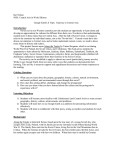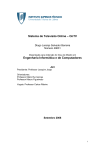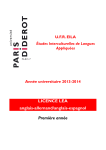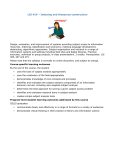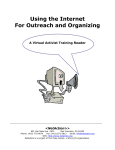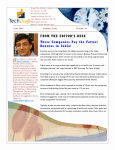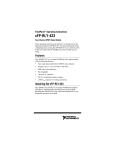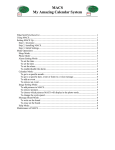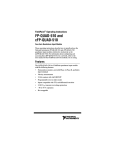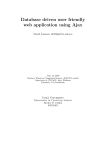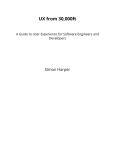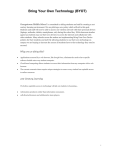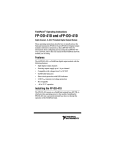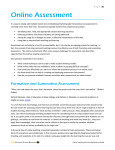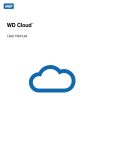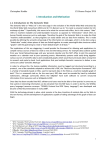Download LIS 467: Web Development and Information Architecture Fall 2011
Transcript
LIS 467: Web Development and Information Architecture Fall 2011 Linda W. Braun, Instructor Email: [email protected] Skype: lbraun2000 Twitter: lbraun2000 AOL IM: lindawbraun Note: This syllabus is not a contract. The instructor reserves the right to alter the course requirements and/or assignments based on new materials, class discussions, or other legitimate pedagogical objectives. COURSE DESCRIPTION Organizing and structuring content to help individuals, communities, and organizations find and manage internal and external Web-based resources and services. Application of current coding, metadata, and style standards to create Web documents. Evaluation of Web site quality and usability, and assessment of resource discovery tools. Strategic planning and user needs analysis for information architecture. Content inventory, organization, and management in support of wayfinding and navigation. Design documents for prototyping large Web sites. Readings, essays, design projects. COURSE POLICIES All students are required to attend class on a regular basis unless prior arrangements are made with the instructor. All students will complete - on time - the assignments as outlined in this syllabus. Assignments that are turned in late will automatically lose points unless accommodations have been made with the instructor prior to the due date of the assignment. All students will abide by the Simmons College honor code, found in the student handbook and detailed online at http://my.simmons.edu/gslis/resources/student- info/ honor-code.shtml For each assignment that requires essay writing and/or the use of quotes or information from additional sources, students are required to use a consistent and recognizable citation style (MLA, APA, Chicago.) All quoted information must be appropriately cited. Assignments should be delivered by uploading files to your web space and linking to the files on your project page on the course wiki. Assignments are due by class time of the due date listed on the syllabus. Assignments that are late without first contacting me to arrange a revised due date are subject to a loss of points prior to grading. Frequent and/or consistent spelling, grammar, and/or style mistakes in written assignments will result in a lesser grade. Reasonable accommodations will be provided for students with documented physical sensory, systemic, cognitive, learning and psychiatric disabilities. If you have a disability and anticipate that you will need reasonable accommodation in this class it is important that you contact the Director of the Academic Support Center, at 617-521- 2471, early in the semester. Students with disabilities are also encouraged to contact their instructors to discuss their individual needs for accommodations. Information on the Academic Support Center is available at http://my.simmons.edu/services/asc. STUDENT LEARNING OUTCOMES Demonstrate the ability to apply standards relevant to specific information service activities. Develop user-centered strategies for solving reference service problems, while Simmons College GSLIS, LIS 467, Fall 2011 demonstrating a command of current issues and trends. Analyze, synthesize, and communicate information and knowledge in a variety of formats. Assess, create, and evaluate systems for managing content. Respond to diversity among individuals and communities through policies, collections, and services. Analyze information problems and develop solutions drawing from a wide range of information technology tools and practices. TEXTS Required There are three books that are required for the class. They are: • Boag, Paul. Website Owner's Manual, Manning, 2009. • Cederholm, Dan. CSS3 for Web Designers, A Book Apart, 2010. • Keith, Jeremy. HTML5 for Web Designers, A Book Apart, 2011. Recommended You will also need to be able to easily access information on how code works - HTML, xHTML, and CSS. Two books that can help you to succeed in this are: • Andrew, Rachel. CSS Anthology, 3rd Edition, 2009. • Castro, Elizabeth. HTML, XHTML and CSS. 6th Edition, 2006. Class Wiki http://gslis.simmons.edu/wikis/lis467_fall2011 Class Location P406 COURSE SCHEDULE: Course Week September 2 Theme/Readings/Etc. Theme: Introduction to the Course/Course Concepts Second half of class in tech lab September 9 Theme: The Why, What, & Who of a Library Website & the Importance of Flexible Standards Based Code Pre-class Reading,/Listening/Viewing • Boag, Paul. Website Owner’s Manual. Chapters 1 & 7. • Keith, Jeremy. HTML5 for Web Designers. Chapters 1 & 2. • Knight, Kayla. Responsive Web Design: What It Is & How to Use It. Available at http://tinyurl.com/3baq7d8 • Ratcliffe, Lindsay. Redesigning Design. Available at http://tinyurl.com/ 673w5xp Second half of class in tech lab Simmons College GSLIS, LIS 467, Fall 2011 September 16 September 23 September 30 Theme: Defining the Architecture & Knowing the Audience Pre-Class Reading/Listening/Viewing • Boag, Paul. Website Owner’s Manual, Chapters 2 and 3. • Chapman, Cameron. Information Architecture 101 http://sixrevisions.com/ usabilityaccessibility/information-architecture-101-techniques-and-bestpractices/ • Head, Alison. http://www.infotoday.com/online/jul03/head.shtml Personas: Setting the Stage for Building Usable Information Sites • O’connor, Kevin. Personas the Foundation for a Great User Experience, http://www.uxmag.com/design/personas-the-foundation-of-a-great-userexperience • WebMonkey. Information Architecture Tutorials. Go through all of the tutorials available in this section of the WebMonkey site - http://tinyurl.com/ 38xypkb Theme: Where Eyes Are on the Screen Pre-Class Reading/Viewing/Listening • Zax, David. The End of Thumbnails and the Future of the Web, available at http://www.fastcompany.com/1718750/the-end-of-the-thumbnail • Gould, Nick. http://uxmag.com/technology/eye-tracking-and-web-usabilitya-good-fit Eyetracking and Web Usability a Good Fit? • Nielsen, Jakob. http://www.useit.com/alertbox/scrolling-attention.html Scrolling & Attention • Nielsen, Jakob http://www.useit.com/alertbox/horizontal-attention.html Horizontal Attention Leans Left • Nielsen, Jakob http://www.useit.com/alertbox/photo-content.html Photos as Web Content • O'Connell, Christi. http://usability.gov/articles/newsletter/pubs/ 032010news.htmlEyetracking at Usability.gov Theme: Defining the Content & Writing for the Web Pre-Class Reading/Viewing/Listening • Gray, Allie. Content Strategy: Optimize Your Efforts for Success. Available at http://tinyurl.com/43h7m3m • Jones, Colleen. Words that Zing http://www.alistapart.com/articles/wordsthat-zing/ • Kissane, Eric. A Checklist for Content Work. Available at http://tinyurl.com/ 4qug47l • Koczon, Cameron. Orbital Content. Available at http://tinyurl.com/5uh6see • Jones, Colleen. Words that Zing http://www.alistapart.com/articles/wordsthat-zing/ Simmons College GSLIS, LIS 467, Fall 2011 October 7 October 14 Theme: Creating the Look and Feel Pre-Class Reading/Viewing/Listening • Boag, Paul. Website Owner’s Manual. Chapter 4. • Evans, Will. Shades of Grey: Wireframes as a Thinking Device. http:// uxmag.com/design/shades-of-grey-wireframes-as-thinking-device • Milles, Anne Sallie. What Web Designers Can Learn from Video Games. Available at http://tinyurl.com/3nwdbf4 • Where Wireframes are Concerned http://uxmag.com/design/wherewireframes-are-concerned • Why Mood Boards Matter available at http://tinyurl.com/8g65ys First half of class in tech lab Theme: Advanced Styles, Media Queries, CSS3, and Responsive Web Design Pre-Class Reading/Viewing/Listening • Gillenwater, Zoey Micklen. Stunning CSS3: Different Screen Size, Different Design. Available at http://tinyurl.com/3wvr5wr • Read all of Cederholm’s CSS3 book for this week. • Read all of Keith’s HTML5 book for this week. October 21 October 28 Second half of class in tech lab Theme: Usability Testing Pre-Class Reading/Viewing/Listening • Boag, Paul. Website User’s Manual. Chapter 6. • Fredhelm, Helge. Why User Experience Can’t Be Designed. Available at http://tinyurl.com/6yfpzze • Colter, Angela. Testing Content. Available at http://tinyurl.com/26wlbkv • Read through all of the sections at Usability.gov (Make sure to go through all of the sub-sections within each section) including: • Basics - http://usability.gov/basics/index.html • Methods - http://usability.gov/methods/index.html • Templates - http://usability.gov/templates/index.html Theme: Search Engine Optimization (SEO) Pre-Class Reading/Viewing/Listening • About Robots Text available at http://tinyurl.com/5vfv2n • Boag, Paul. Website Owner’s Manual. Chapter 10. • Ostroff, Len. Four Simple Ways to Rething SEO. Available at http:// tinyurl.com/3bbllxr • Titlow, John Paul. Optimize Your Web Content as you Write. Available at http://tinyurl.com/3oqoasa Simmons College GSLIS, LIS 467, Fall 2011 November 4 Theme: Going Mobile Pre-Class Reading/Viewing/Listening • Connolly, Matthew, et al. Mobilizing the Library’s Web Presence and Services. Reference Librarian, Special Issue, Volume 52 Issue 1/2. Pages 27-35. • Koch, Peter-Paul. http://www.alistapart.com/articles/smartphone-browserlandscape/ Smartphone Browser Landscape • Perez, Sarah. 10 Mobile Trends of 2011. http://www.readwriteweb.com/ mobile/2011/01/2011-mobile-trends-a-look-ahead.php November 11 Theme: Content Management Systems (CMS) Pre-Class Reading/Viewing/Listening • Boag, Paul. Website Owner’s Manual, Chapter 8. • Becker, Danielle. A dventures in Drupal: Designing a Library Website Using a CMS. Online, Sept/Oct 2010. • Clark, Dave. Content Management & the Separation of Presentation and Content. Technical Communication Quarterly, Winter 2008Ed, 2009. • Prideaux, Rob. What does a Content Management System Do? http:// www.techsoup.org/learningcenter/webbuilding/archives/page9347.cfm November 18Theme: Thinking Forward Pre-Class Reading/Viewing/Listening • Kim, Ryan. http://gigaom.com/2011/01/14/feature-creep-emerges-as-nextchallenge-for-mobile-devs/ Feature Creep Emerges as the Next Challenge for Mobile Devs • Nielsen, Jakob. Ipad Usability Year One. Available at http://useit.com/ alertbox/ipad.html • Warren, Christina. 7 Hot Trends in Mobile App Design. http:// mashable.com/2011/01/26/mobile-app-design-trends/ • Gordon, Jen. Useful Design Tips for Your iPad App. http:// www.smashingmagazine.com/2010/04/16/design-tips-for-your-ipad-app/ Guest Speaker via Skype: Matt Bassett from One Hundred Robots December 2 Theme: The Final Site, Part 1 - Group Presentations Each group will prepare a 15 minute presentation on their final project website. Specifics on what to include in the presentation are available on the class wiki. All groups should be ready to answer questions from their classmates and the instructor during or after their presentation. Entire class will take place in the Tech Lab December 9 Web Development Challenge Come to class ready to talk about two articles (published within the last 18 months) you read from one of the following resources: • A List Apart • Smashing Magazine • BoagWorld • UX Magazine Meaning of Grades A “B” grade means that the work handed in is satisfactory and meets the requirements of the Simmons College GSLIS, LIS 467, Fall 2011 assignment. “B+” means that you have done more than meet the minimum requirements. An “A” grade means that the assignment is excellent. Anything below a “B” means that there were problems with the assignment meeting the minimum requirements. To view the grading system at GSLIS, go to: http://www.simmons.edu/gslis/resources/forms/policies.php#grades GRADING SCALE 97 – 100 A 92 – 96 A- 87 – 91 B+ 82 – 86 B 77 – 81 B- 72 – 76 C+ 67 – 71 C 62 – 66 C- Below 61 F STATEMENT ON DUE DATES All materials must be submitted on time. Permission to submit material late will be handled by the instructor on a case-by-case basis. The instructor must be notified of any problems before a due date. You must request a consultation with the professor to use this option. Documentation may be required. Otherwise, ten percent will be deducted for each day work is late. All assignments are to be submitted on the dates indicated in this syllabus. (If a student faces a major life crisis that prohibits the completion of his/her work for this course, the student needs to contact GSLIS and follow the established regulations and guidelines. The instructor would also appreciate prompt notification of any major problems. Confidentiality will be maintained.) ASSIGNMENT OVERVIEW & DATES Assignment Title # of PTs Due Date Submitted By Code Trial 1 5 September 16 Each student Creative Brief 10 September 23 Group Site IA 10 September 30 Group Code Trial 2 5 October 7 Each student Wireframes 10 October 14 Group Mood Board 10 October 14 Group Usability Plan 10 October 28 Group One Page Coded 15 November 4 Group Final Site 15 December 2 Group Collaboration/Class Participation 10 Throughout class Each student & Group Each of the assignments required for this class build upon each other and lead to the Simmons College GSLIS, LIS 467, Fall 2011 final site you need to complete by December 2. Designing a website is a process that includes regular revision. You should be prepared to revise the assignments you complete after receiving instructor feedback. All assignments should be delivered by uploading files to your web space and then linking to the file(s) on the project pages located on the course wiki. Class Collaboration & Participation The first week of class you will be assigned to a group with other classmates. Throughout the semester you will work together in your group i to work towards completing the final project website. The first week of class you will select the site that you are going to develop and in the following weeks you’ll work together on the creative brief, the site information architecture, the wireframe, the usability testing, and the overall coding and design. Each person in the group will have a specific role; all group members must work together and provide continued feedback and support along the way. The teams will be made up of: • Information Architect & Usability Expert: Lead on the Site IA and Usability Testing Plan assignments. Co-lead on the Wireframe assignment • Usability Expert: Co-lead on the Wireframes and lead on the Usability Testing Plan assignment • Lead Designer: Co-lead on the Wireframe and lead on the Mood Board assignment • Lead Coder: Lead on the One Page Coded and Final Site assignments The group will determine the lead for the Creative Brief assignment and also who is responsible for managing the written content for the site. Some weeks in preparation for class or during class you will also be asked to take part in activities based on the pre-class reading listed in the syllabus and on the wiki. It is expected that all students will actively participate in those class-based activities as well. Total points for collaboration & class participation = 10 Code Trial 1 For the first code trial you need to create a web page about yourself that uses CSS and HTML techniques covered so far in the class. The look and feel of the page along with the content should inform me, and your classmates, about you. When the files are complete you need to upload the files (including any images you are using) to your Simmons web space. Information on how to upload to your web space is available on the course wiki. Once you have uploaded your files you should create link to your file on the code trial 1 assignment page on the class wiki. Grading for Code Trial 1 For this assignment students will receive all 5 points by demonstrating use the HTML and CSS techniques covered in the first weeks of class. This goal of the assignment is to get students in the class writing code immediately and is designed to give me a chance to discover what isn’t making sense for each student, and provide feedback accordingly. Points will be taken off if the assignment is turned in late – without permission before the date it is due. Simmons College GSLIS, LIS 467, Fall 2011 Due September 16 Creative Brief A creative brief outlines the purpose and audience for a website. It allows those working on a website to analyze what they hope to achieve and look at similar resources and "competition" in order to articulate, in writing, a framework for the site. At each of the steps in the web building process you will review the creative brief in order to guarantee that you remain on target with the final product. A template for the creative brief is available on the course wiki. Your group will complete the template for this assignment. When the template is complete one member of your group will upload it to his/her Simmons web space and link to it on the Creative Brief assignment page on the class wiki. Grading for the Creative Brief Up to 2 points for answering each question on the creative brief template and in the form and detail specified for each. Up to 5 points for including complete answers to each question on the creative brief template. For example, when asked to include the title, URL, and specifics about what works or doesn’t work for sites similar to the one the group is working on, all of those components have to be included. Up to 3 points for demonstrating time and thought spent considering the audience, goals, and style of the site. These will be demonstrated through the information provided on the creative brief that shows answers directly connect to what the group will work on. For example, images outlined, the persona created, and so on directly relates to the website the group will work on during the semester. Points will be taken off if the assignment is turned in late – without permission before the date it is due. Total Points for the Creative Brief = 10 Due September 23 Site IA The way a site is organized, the information architecture, can make or break its success. It's important to work out an information architecture plan early in the development process as that sets the flow of the content of the site. For this assignment your group will create an IA using a piece of software of your choice. Possible products to use include: Inspiration Visio Bubbl.us Gliffy Mindmeister The IA should include: A structure that demonstrates how pages of the site connect (and don't connect) to each other. Labels for each of the sections and pages of the site. (These should be the labels you plan on using in the final design. They may change but try to be as accurate as possible in the IA that you develop for this assignment.) Simmons College GSLIS, LIS 467, Fall 2011 IA examples are available on the class wiki When your group’s site IA is complete one group member should upload the file to his/her Simmons space and create a link to the diagram on the IA assignment page of the class wiki. Grading for Site IA Up to 4 points for the development of an information architecture diagram that includes all of the pages of the site and demonstrates how the pages connect to each other. Up to 4 points for a labeling system for pages that shows the use of terms and phrases that are appropriate to the audience and purpose of the site. For example, if creating a site for teachers, the language used in the IA should reflect teacher understanding of content provided. Up to 2 points for including persistent, secondary, and tertiary elements in the diagram as needed. Remember, the site IA should be the site you are developing not the IA of the site that you are re-designing as it exists now. Points will be taken off if the assignment is turned in late – without permission before the date it is due. Total points for the site IA = 10 Due September 30 Code Trial 2 In this second code trial you need to expand on the code and styles you used for the first code trial. The content is up to you. When the code and CSS is complete you need to upload the files (along with any images you are using) to your Simmons web space. Once you have uploaded your files you should add a link to the code trial 2 assignment page on the class wiki. Grading for Code Trial 2 Code trial 2 will be graded on the integration of feedback from code trial 1 and integration of new HTML and CSS techniques discussed prior to the assignment dues date. Points will be taken off if the assignment is turned in late – without permission before the date it is due. Total points for Code Trial 2 = 5 Due October 7 Wireframe The wireframe is a visual representation of the front page and (in this case) one internal page of the site. This visual composite helps to take what you have developed in writing only so far (the Simmons College GSLIS, LIS 467, Fall 2011 creative brief and IA) into visual form. The comp. you create for this class should show the: Layout you are planning for the front page and one internal page of the site (this should include all navigation, labels, image placement, headings, and text placement.) Navigation for the site - including labels that are as accurate as possible at the time you finish the assignment. Placement of images on the page. You should use images that represent as closely as possible the actual images you will use on the site. Location, size, and type of headings you will use on the page. Placement of text on the page that shows size, type, and so on. Wireframe examples are available on the course wiki. When your group completes your wireframes one member should upload them to his or her Simmons web space and place a link to the wireframes on the wireframes page on the class wiki. Grading for the Wireframes Up to 2 points for creating a wireframe for the home page and one internal page Up to 4 points for creating wireframes that include full details on layout including placement of images, navigation, headings, text, etc. Up to 4 points for including full information on the colors, fonts, and sizes of text, images, and elements to be included on the pages covered in the wireframes. Points will be taken off if the assignment is turned in late – without permission before the date it is due. Total points for wireframes = 10 Due October 14 Mood Board The mood board should provide a sense of the look and feel of the site you are developing. It should pull together your group’s ideas related to colors, fonts, images, and so on and should present an overall mood for the site via those elements. The mood board should be uploaded to a group member’s Simmons web space and linked on the mood board assignment page on the class wiki. Grading for the Mood Board • Up to 3 points for including a set of fonts that are suggested for use on the site and meet the needs of the audience and purpose. • Up to 3 points for including a set of images that reflect the style of images the site’s audience and purpose. • Up to 3 points for including a selection of colors that it is expected will be used on the site in order to meet the needs of the site’s audience and purpose. • Up to 1 point for submitting a mood board that integrates all of the above elements together to successfully create a specific mood – the elements need to be cohesive and be shown as working together. Points will be taken off if the assignment is turned in late – without permission before the date it is due. Simmons College GSLIS, LIS 467, Fall 2011 Total points for the mood board = 10 Due October 14 Usability Testing Plan If you build a website that isn't easy for your audience to use you have basically failed in the task. It's important to test the site with users at several points along he way in the development process. You won't be able to do that in this class. However, for this assignment you should develop a user-testing plan that you could integrate into a real- world web design project. When developing your own plan: • • • Outline the scenario for the testing - when will it take place in the web development process, who will be involved, what will the setup of the testing be? 8 to 10 questions/scenarios which you would ask those participating in the testing. What you want to find out about the site via the answers provided. When your group’s user-testing plan is complete one member should upload the file to his/her Simmons web space and place a link that file on the usability testing plan wiki page. Examples are available on the class wiki. Grading for Usability Testing Plan • • • • Up to 1 point for at least 8 questions and scenarios that relate to testing for the site under development. Up to 3 points for inclusion of full scenarios that include details that put the person taking the test in a specific framework Up to 3 points for including specific reasons for why each question or scenario will help to provide information about the success of the site. Up to 3 points for including questions at the beginning and end of the plan that at the start help give the person taking the test an opportunity to become comfortable with the site and the experience and at the end help to provide opportunities for processing thoughts about the site. Points will be taken off if the assignment is turned in late – without permission before the date it is due. Total points for Usability Testing Plan = 10 Due October 28 One Page Coded Once you create the wireframe for your site it's time to turn that look and feel into an actual web page. For this assignment you need to do just that. Turn the design in your head and on paper into an actual web page that includes images, links, navigation, and blocks of content. In grading and reviewing the page of code I will look at the implementation of the code, navigation, and design. The feedback your group receives on this page will help you move forward in coding the rest of the site. Simmons College GSLIS, LIS 467, Fall 2011 When your group’s page is coded one member should upload the files and images to his or her Simmons web space and then place a link on the one page coded assignment wiki page. Grading for One Page Coded Up to 4 points for integrating the design of the original wireframes (along with instructor feedback) into the page design. Up to 4 points for using HTML and CSS techniques discussed in the class including flexible and elastic design. Up to 2 points for validating the HTML at the W3C Up to 2 points for validating the CSS at the W3C Up to 3 points for including all page content – text, headings, navigation, images, colors, etc. Please Note: This assignment is a group’s opportunity to try things out for, and receive feedback on, their final site. If a technique is unclear or code isn’t working as expected, if comments are included in the HTML and CSS files explaining what was confusing, not working, etc. that will be taken into account at grading. Points will be taken off if the assignment is turned in late – without permission before the date it is due. Total points for One Page Coded = 15 Due November 4 Final Site After completing each of the previous assignments your group should have a good idea of what your site is going to look like, the content it will include, and how the pages do and do not connect to each other. For the final assignment your group needs to complete a minimum of 10 pages of the site you've been working on for this class. The site should include: A consistent navigational structure that meets the needs of the audience and purpose of the site A consistent design that meets the needs of the audience and purpose of the site Images that support the audience and purpose of the site Text that is written is a style appropriate to the audience and purpose of the site and the web format Colors that support the needs of the audience and purpose of the site When your group’s site is complete one group member should upload all files to his or her Simmons web space and link to the main page of the website on the wiki assignment page for the final site. Grading for the Final Site Up to 5 points for integrating the design of the original wireframes (along with instructor feedback) into the page design. Up to 5 points for using HTML and CSS techniques discussed in the class including flexible and elastic design. Up to 2 points for validating the HTML at the W3C Up to 2 points for validating the CSS at the W3C Up to 3 points for including all page content – text, headings, navigation, images, colors, etc. Up to 3 points for integrating feedback from the instructor on design, code, and content. Simmons College GSLIS, LIS 467, Fall 2011 Please note: If instructor feedback is not integrated, comments need to be included in the code as that fully explains why the feedback was not used and should be directly connected to the site audience and purpose. Points will be taken off if the assignment is turned in late – without permission before the date it is due. Total points for the Final Site = 15 Due December 2 Simmons College GSLIS, LIS 467, Fall 2011













